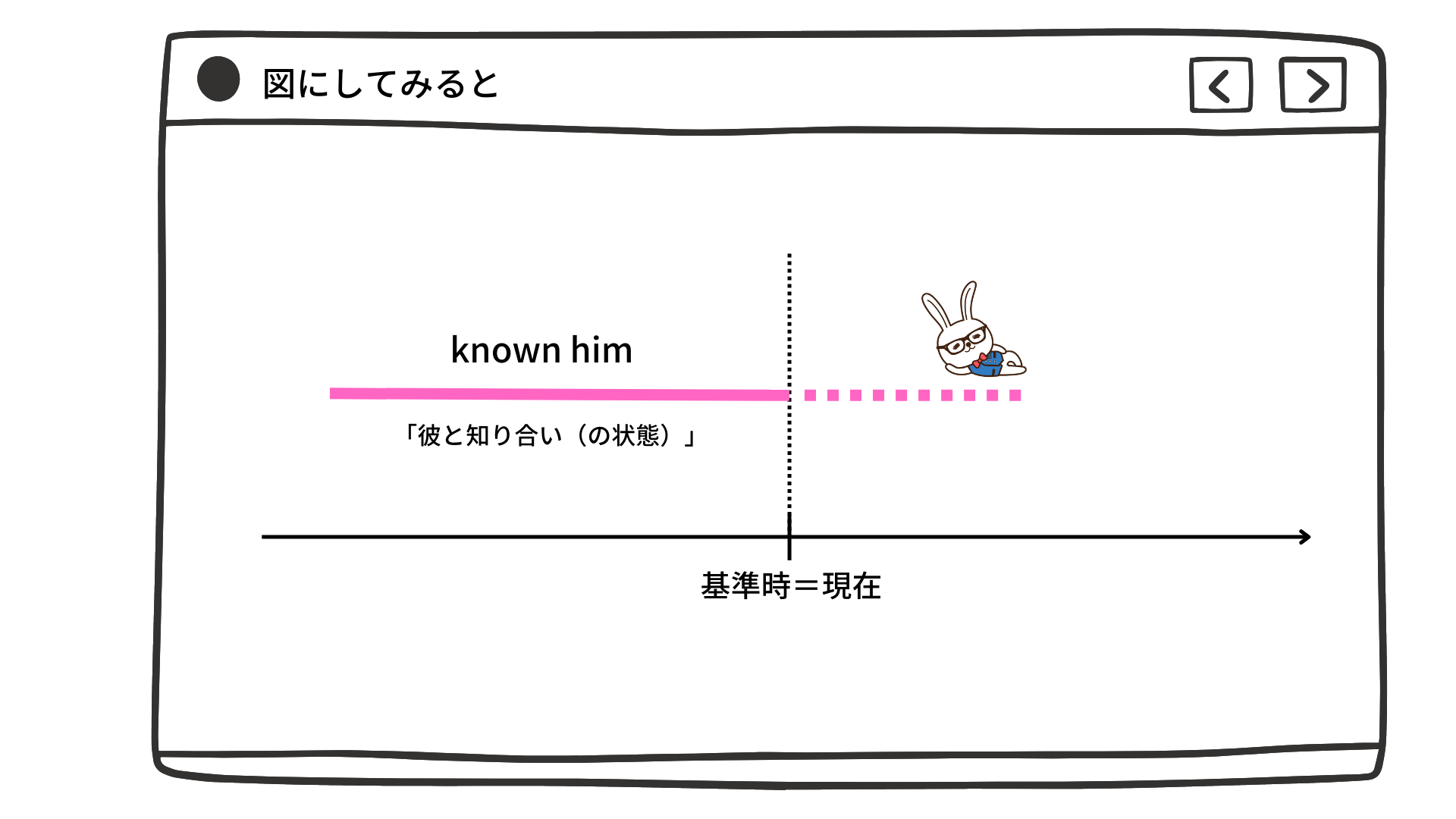1-5 「〜になる」の表現
ここでは「〜になるの表現」の演習を行います。
以下の問題に挑戦してみましょう!
[box03 title=”「〜になる」の表現”]
問 以下の日本文を英訳してください。
17. 私はずっとその演奏会のチケットを手に入れようとしてきたが、うまくいかなかった。
18. 私が最初に英語を教わった先生は、日本で30年暮らしていて、日本語がペラペラのアイルランド人 (Irish) 女性でした。
19. ロンドンに着いて1週間と経たないうちに、ニューヨーク支社に飛ぶように東京本社から電子メールがきた。
20. 今月の終わりで、私たちは英語を10年間学んでいることになる。
[/box03]

解答・解説(その17)
17. 私はずっとその演奏会のチケットを手に入れようとしてきたが、うまくいかなかった。
公式
| 「ずっと〜を手に入れようとしてきた」 | S have been trying to get ~ |
[jin-iconbox01]現在も手に入れられていないので、現時点までの状態の継続と考え、現在完了形を使います。[/jin-iconbox01][jin-iconbox01]”try to do ~” は 動作動詞 なので、”have been trying to do ~” と進行形にします。[/jin-iconbox01]
[box03 title=”完了形の復習”]以下のように表現すれば、完了形の状態の継続「ずっと〜している」を表現することができます。
① 状態動詞 の時
| have | p.p. – |
| 基準時=現在 | 「〜している」(状態) |
「 “have” (→ 基準時=現在)」+「”p.p. ~”(→ 状態)」
→「現在まで状態が続く」
(例)I have known him for 10 years. 「彼とは10年来の友人です」

② 動作動詞 の時
| have | been -ing |
| 基準時=現在 | 「〜している」(状態) |
「 “have” (→ 基準時=現在)」+「”be -ing”(→ 状態)」
→「現在まで状態が続く」
(例)It has been snowing since last night. 「昨晩からずっと雪が降っている」
* 完了進行形(have been -ing)は「その状態がその先も続く可能性が高いと話し手が思っている」ことを暗示します。
(注)動作動詞で “have p.p. ~” とすると、完了形の「完了」か「経験」になります。
[/box03]
語句
| 「その演奏会の1枚のチケット」 | ① a ticket for the concert |
| ② a ticket to that concert |
[jin-iconbox01]「〜のチケット」は “a ticket for[to] ~” と表現します。
→ “× a ticket of ~” とはならないことに注意しよう![/jin-iconbox01][jin-iconbox01]”a concert ticket” では「その演奏会のチケット」の「その」を表せないので、上記の表現を使います。[/jin-iconbox01][jin-iconbox01]”× the ticket for the concert” としてしまうと「1枚しか販売されていないチケット」の意味になるので不可です。
[jin_icon_chick size=”32px” color=”#fc65dc”] 比較してみよう!
| a ticket for the concert | 複数枚販売されている中の1枚のチケット |
| my ticket for the concert | 複数枚販売されている中の 私の1枚のチケット |
| some tickets for the concert | 複数枚販売されている中の何枚かのチケット |
| the ticket for the concert | 1枚しか販売されていない中の1枚の(唯一の)チケット |
| the tickets for the concert | 複数枚販売されている中の全てのチケット |
“a” と “the(= one and only)” はとても奥深いです。[参考書リスト] にある文献を何冊か読んでみましょう!
[/jin-iconbox01]
「チケット」の呼び名を覚えよう!
| 「列車の切符(乗車券)」 | a train ticket |
| 「バスの切符」 | a bus ticket |
| 「定期乗車券」 | a commuter ticket |
| 「コンサートの入場券」 | a concert ticket |
| 「劇場の入場券」 | a theater ticket |
| 「航空券」 | a plane[an airline] ticket |
| 「食事券」 | a meal ticket |
| 「宝くじ」 | a lottery ticket |
| 「ワールドカップ決勝戦の切符」 | a ticket to the World Cup final |
“(Admission) by ticket only.” 「切符のない方の入場お断り・チケットが必要です」のような入場制限を表示する英語(* 看板などに使われる)もあります。
解答例
・ I have been trying to get a ticket for the concert, but in vain.
[karma_by_kadar__simple_player title=”文の読み上げ” src=”https://eigo-banchou.com/wp-content/uploads/2022/03/speech_20220303061034062.mp3″ volume=”0.9″ color=”5″]
[jin-iconbox01]”have been trying to get ~” で「ずっと〜を手に入れようとしてきた」の意味です。[/jin-iconbox01][jin-iconbox01]”in vain” は「無駄に・成果なく・無意味に」の意味です。[/jin-iconbox01]
・ In spite of my efforts over a long time, I have not been able to buy a ticket for the concert.
[karma_by_kadar__simple_player title=”文の読み上げ” src=”https://eigo-banchou.com/wp-content/uploads/2022/03/speech_20220303061251970.mp3″ volume=”0.9″ color=”5″]
[jin-iconbox01]”in spite of ~” は「〜にも関わらず・〜を無視して」の意味です。[/jin-iconbox01][jin-iconbox01]”over a long time” は形容詞句で、直前の “my efforts” を修飾しています。
“my efforts over a long time” で「長期間にわたる努力」の意味になります。[/jin-iconbox01][jin-iconbox01]”be able to do ~” の “be 動詞” は状態動詞なので、”have not been able to do ~” で「ずっと〜できなかった」という状態の継続になります。[/jin-iconbox01]
解答・解説(その18)
18. 私が最初に英語を教わった先生は、日本で30年暮らしていて、日本語がペラペラのアイルランド人 (Irish) 女性でした。
公式
| 「30年暮らしていた」 | had lived in Japan for 30 years |
[jin-iconbox01]過去の1点までの話をしているので、過去完了(had p.p. ~)を使います。[/jin-iconbox01][jin-iconbox01]”live” は状態動詞なので、”had lived” で過去完了の状態の継続(ずっと〜していた)になります[/jin-iconbox01]
語句
| 「私が最初に英語を教わった 先生」 |
| ① my first English teacher |
| ② the first teacher who taught me English |
[jin-iconbox01]”△ the teacher who taught me English first” と “first” を文末(or 文頭)に置くと 「第一に・真っ先に・最初に」の意味になり、「私に英語を 最初に 教えた 先生」の意味になります。
「2番目」「3番目」に教えた先生との対比になり、この文章では不自然です。
(例) Tom came first. 「トムが最初に来た」
他の人が2番目・3番目に来たことを暗示します。
文末に “first” が置かれることで、焦点があたり(* 文末焦点)、他者との対比がより強調されます。[/jin-iconbox01][jin-iconbox01]”× the teacher who first taught me English” と “first” を動詞の前に置くと “for the first time” の意味になり、「英語を 初めて 教えた 先生」の意味になります。[/jin-iconbox01][jin-iconbox01] “× the teacher who taught me English for the first time” と書くと、「英語を 初めて 教えた 先生」=「先生の最初の生徒」の意味になり、先生の経験を述べる文章になってしまいます。[/jin-iconbox01][jin-iconbox12]”for the first time” と “first” の違い
| for the first time | 「初めて」 |
| → 経験した出来事が初めてであることを強調する表現です。 |
(例)I visited Tokyo for the first time yesterday.
「昨日、初めて東京に行った」
| first | 「初めて」 * この意味の時は通例、動詞の前に置きます。 * 強調形は for the first time |
| → 何回か経験した中の最初を強調する表現です。 |
(例)When did you first see Mr. White?
「初めてホワイトさんに会ったのはいつですか」[/jin-iconbox12]
| 「日本語がペラペラ」 | ① speak(V) English(O) fluently(副) |
| ② speak(V) fluent Japanese(O) | |
| ③ be fluent in (speaking) Japanese | |
| ④ be a fluent speaker of Japanese |
[jin-iconbox01]”① fluently” は「流暢に・すらすらと」の意味の副詞です。[/jin-iconbox01][jin-iconbox01]”③ be fluent in (speaking) ~” は「〜をすらすらと話せる・〜を流暢に話す」の意味です。[/jin-iconbox01]
解答例
・My first English teacher was Irish, and she had lived in Japan for 30 years and spoke Japanese fluently.
[karma_by_kadar__simple_player title=”文の読み上げ” src=”https://eigo-banchou.com/wp-content/uploads/2022/03/speech_20220303100800098.mp3″ volume=”0.9″ color=”5″]
[jin-iconbox01]”Irish“「アイルランド人の・アイルランドの」の代わりに “an Irish woman”, “an Irishwoman”も可です。
→ “Irishwoman” は「アイルランド人の女性」の意味の名詞です。[/jin-iconbox01][jin-iconbox01]「私が最初に英語を教わった」過去の時点ですでに30年間日本に暮らしていたので、”had lived” (過去完了)を使います。
→ 過去の一点までの状態の継続は過去完了で表します。[/jin-iconbox01][jin-iconbox01]「私が最初に英語を教わった」過去の時点で「日本語が話せた」ので “spoke Japanese fluently” で表します。
→ 過去の習慣的な動作は 過去形 で表します。
→ “× had spoken …” だと過去の1点までの話になり、”× was speaking …” だと過去の一点における状態(割と近い時期にその動作が終わる)の意味になるので、どちらも不可です。[/jin-iconbox01]
・The first teacher(S) who taught me English was(V) an Irish woman(C) who had lived in Japan for 30 years and spoke fluent Japanese.
[karma_by_kadar__simple_player title=”文の読み上げ” src=”https://eigo-banchou.com/wp-content/uploads/2022/03/speech_20220303110121768.mp3″ volume=”0.9″ color=”5″]
[jin-iconbox01] “The first teacher who taught me English” で「私に英語を教えた 初めての先生」の意味です。[/jin-iconbox01][jin-iconbox01]”had lived in Japan for 30 years” で「(過去のある時点 =”taught me English” で)30年日本に住んでいた」の意味です。
→ 過去の一点までの継続は “had p.p.” で表します。[/jin-iconbox01][jin-iconbox01]”spoke fluent Japanese” の “spoke” は「過去のある時点(=”taught me English”)における習慣的な動作」を表します。[/jin-iconbox01][jin-iconbox12]問題文に近い英訳をするとこのようになります。
しかしながら、かなり読みづらい英文になってしまいます。最初の解答例のように、いくつかに分けた方が良いでしょう。[/jin-iconbox12]
解答・解説(その19)
19. ロンドンに着いて1週間と経たないうちに、ニューヨーク支社に飛ぶように東京本社から電子メールがきた。
公式
| 「Sが〜しないうちにS’が…した」 |
| S hadn’t done 〜 when[before] S’ did … |
[jin-iconbox01]直訳は「S’が…した時には、Sは〜していなかった」です。[/jin-iconbox01][jin-iconbox12]かなり覚えづらい公式なので、「直訳」→ 「英訳」→「(公式の)訳」の順で確認して覚えよう![/jin-iconbox12]
語句
| 「ニューヨーク支社に飛ぶようにという 電子メール」 |
| ① an E-mail telling me to fly to New York branch |
| ② an E-mail which say I should fly to the New York branch |
| ③ an E-mail which ordered me to fly to the New York branch |
[jin-iconbox01]込み入った説明は分詞か関係詞で書きます。[/jin-iconbox01][jin-iconbox01]”① tell O to do ~” は「O(人)に〜するように言う」の意味です。
”① fly to ~” で「(飛行機で)〜に飛ぶ」の意味です。
“① branch” で「支店・支社・支局」の意味です。[/jin-iconbox01][jin-iconbox01]”③ order O to do ~” で「O(人)に〜せよと命じる」の意味です。[/jin-iconbox01]
| 「ニューヨーク支社」 | the New York branch |
[jin-iconbox01]”× a branch company“, “× a child company”, “× a small office” は不可です。[/jin-iconbox01]
| 「東京本社」 | ① the Tokyo headquarters |
| ② the main office | |
| ③ the head office |
[jin-iconbox01]”headquarters” は「(会社の)本社」の意味です。(単複同形)[/jin-iconbox01]
解答例
・I hadn’t been in London for a week when an E-mail from the Tokyo headquarters(S’) arrived(V’) telling me to fly to the New York branch.
[karma_by_kadar__simple_player title=”文の読み上げ” src=”https://eigo-banchou.com/wp-content/uploads/2022/03/speech_20220304054058341.mp3″ volume=”0.9″ color=”5″]
[jin-iconbox01]”S hadn’t done 〜 when[before] S’ did …”
「S’が…した時には、Sは〜していなかった」【直訳】
→『Sが〜しないうちにS’が…した』[/jin-iconbox01][jin-iconbox01]”be + 場所” で「〜にいる」「〜にある」の意味です。
→ 今回は “be in London” 「ロンドンにいる・滞在する」となります。[/jin-iconbox01][jin-iconbox01]”from the Tokyo headquarters” は形容詞句で直前の “an E-mail” を修飾しています。
→ 全体で “an E-mail from the Tokyo headquarters” 「東京本社からの電子メール」の意味になります。[/jin-iconbox01][jin-iconbox01]”telling me to fly to the New York branch” は分詞の形容詞用法です。
when節の主語 “an E-mail” を修飾しています。
この解答例のように、元々の主語が長い場合は、それにかかる修飾語(関係詞や分詞などの形容詞句・節)を引き離して、文の後ろに置くことがあります。[/jin-iconbox01][jin-iconbox12]この解答例を以下のように書くと主語が長すぎてバランスが悪くなります。
I hadn’t been in London for a week when an E-mail(S’) from the Tokyo headquarters / telling me to fly to the New York branch arrived(V’).
上の解答例のように、”telling me …” の部分を文末(arrived の後ろ)に置いた方が良いでしょう。
また、内容的にも “telling me to fly to the New York branch” の部分が一番重要なので、文末において焦点を当てた方が伝わりやすい表現になります。[/jin-iconbox12]
・ I had not yet been in London for a week when I received an E-mail from the main office in Tokyo which said I should fly to the New York branch.
[karma_by_kadar__simple_player title=”文の読み上げ” src=”https://eigo-banchou.com/wp-content/uploads/2022/03/speech_20220304080934517.mp3″ volume=”0.9″ color=”5″]
[jin-iconbox01]”S hadn’t done 〜 when[before] S’ did …”
「S’が…した時には、Sは〜していなかった」【直訳】
→『Sが〜しないうちにS’が…した』[/jin-iconbox01][jin-iconbox01]”not … yet” で「まだ〜ない」の意味です。
通例、yet は文末に置かれます。
(例) I haven’t finished my assignments yet.
「まだ宿題を終えていません」
解答例のような “not yet” の形は書き言葉に見られる形で、堅い表現になります。[/jin-iconbox01][jin-iconbox01]「東京本社」を “the main office in Tokyo” としました。[/jin-iconbox01][jin-iconbox01]関係詞節 “which said I should fly to the New York branch” は “an E-mail” を修飾しています。[/jin-iconbox01]
・ Before I had been in London for a week, an E-mail(S) came(V) from the main office(前) in Tokyo(前)which ordered me to fly to our branch office in New York.
[karma_by_kadar__simple_player title=”文の読み上げ” src=”https://eigo-banchou.com/wp-content/uploads/2022/03/speech_20220304083423986.mp3″ volume=”0.9″ color=”5″]
[jin-iconbox01]”Before I had been in London for a week” は「私がロンドンに1週間滞在したのより前に」→『私がロンドンに着いて1週間と経たないうちに』の意味です。
before + S have [had p.p.] は未完了を強調します。
→ before(〜より前に)+ S have[had p.p.](完了を表す)[/jin-iconbox01][jin-iconbox12]”before + S had p.p. ~” は「〜しないうちに」「〜しきらないうちに」という 意外性 を暗示します。
(例) Before I had parked my car, she was opening the door.「私が車を停めもしないうちに、彼女はドアを開けていた」【Genius 5th】
“Before”「〜する前に」
+ “I had parked my car”「私が車を停めた」
→「私が車を停めたのより前に」
→『私が車を停め切るより前に』
→『車を停めもしないうちに』 【未完了を強調・意外性を暗示】
(例) Ann wrote the review before she had read the whole book. 「アンはその本を全部読み終えずに書評を書いた」【Wisdom】
“before”「〜する前に」
+ “she had read the whole book”「彼女がその本を全部読んだ」
→「彼女がその本を全部読んだのより前に」
→『彼女がその本を全部読終えずに』
→『彼女がその本を全部読み終えないうちに』【未完了を強調・意外性を暗示】
[/jin-iconbox12][jin-iconbox01]関係詞節 “which ordered me to fly to our branch office in New York.” は 主語 “an E-mail” を修飾しています。[/jin-iconbox01]
解答・解説(その20)
20. 今月の終わりで、私たちは英語を10年間学んでいることになる。
公式
| 「〜の終わりで…していることになる」 |
| By the end of 〜, I will have been -ing … |
[jin-iconbox01]未来の一点までの継続を表すので、「未来完了の状態の継続」を使います。
完了形の継続の形については 「その17」を参照してください。[/jin-iconbox01][jin-iconbox01]”study” は動作動詞なので、”will have been studying[learning]” と進行形にします。[/jin-iconbox01]
語句
| 「今月の終わりで」 | ① by the end of this month |
| ② at the end of this month |
[jin-iconbox01]「今月の終わりまでに」(完了)と考え、”by ~” 「〜までには」を使います。[/jin-iconbox01][jin-iconbox01]時間の地点と考え、”at the end of this month” も可です。[/jin-iconbox01][jin-iconbox12]”× in the end of ~” とすると、「〜の間に」という期間の意味になります。[/jin-iconbox12][jin-iconbox12]”× until[till] the end of this month” は不可です。
until[till] は「〜まで」という「継続」を表します。[/jin-iconbox12]
| 「10年間」 | ① for ten years |
| ② for a decade |
[jin-iconbox01]”decade” は「10年間」の意味です(* 可算名詞)。
アクセントは “dec-ade”(第1アクセント)です。[/jin-iconbox01]
解答例
・ By the end of this month, I will have been studying[learning] English for ten years.
[karma_by_kadar__simple_player title=”文の読み上げ” src=”https://eigo-banchou.com/wp-content/uploads/2022/03/speech_20220305031104150.mp3″ volume=”0.9″ color=”5″]
[jin-iconbox01]”By the end of this month” は「今月の終わりまでには」の意味です。
未来の一点まで(=「今月の終わり」)の完了(=「までには」)を表します。[/jin-iconbox01][jin-iconbox01]”I will have studied” とすると、「(今月の終わりまでに)英語の学習が終わる」という「完了」か「経験」の意味になってしまいます。
この問題文では、その後も英語の勉強が続くと考え、未来完了の「継続」にします。[/jin-iconbox01]


